Air Asia: Strategic Management Analysis and Marketing Mix Strategies
VerifiedAdded on 2023/04/08
|20
|4338
|347
Report
AI Summary
This report provides a comprehensive strategic analysis of Air Asia, focusing on its internal and external business environments. It begins with an executive summary highlighting the challenges and opportunities faced by Air Asia, particularly within the Asian market. The report employs PESTLE and SWOT analyses to evaluate political, economic, social, technological, legal, and environmental factors, as well as the airline's strengths, weaknesses, opportunities, and threats. A competitive analysis is also included. The report then assesses Air Asia's current strategy and recommends new premium services to cater to a wider customer base. Segmentation, targeting, and positioning analyses are performed, followed by a discussion of the marketing mix elements (product, price, promotion, and place) tailored for the recommended premium services. The conclusion emphasizes the importance of effective implementation of these elements to help Air Asia succeed in the premium segment.
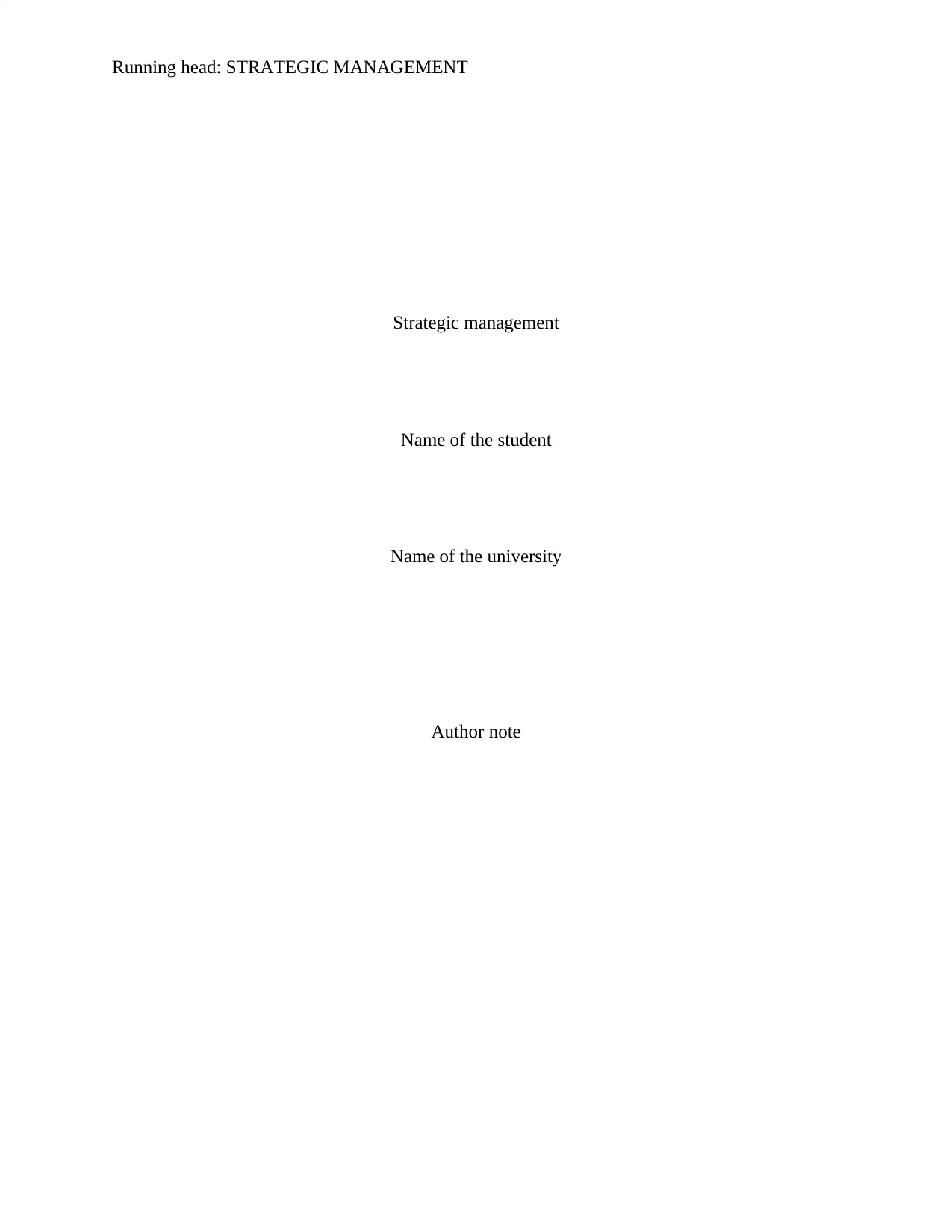
Running head: STRATEGIC MANAGEMENT
Strategic management
Name of the student
Name of the university
Author note
Strategic management
Name of the student
Name of the university
Author note
Paraphrase This Document
Need a fresh take? Get an instant paraphrase of this document with our AI Paraphraser
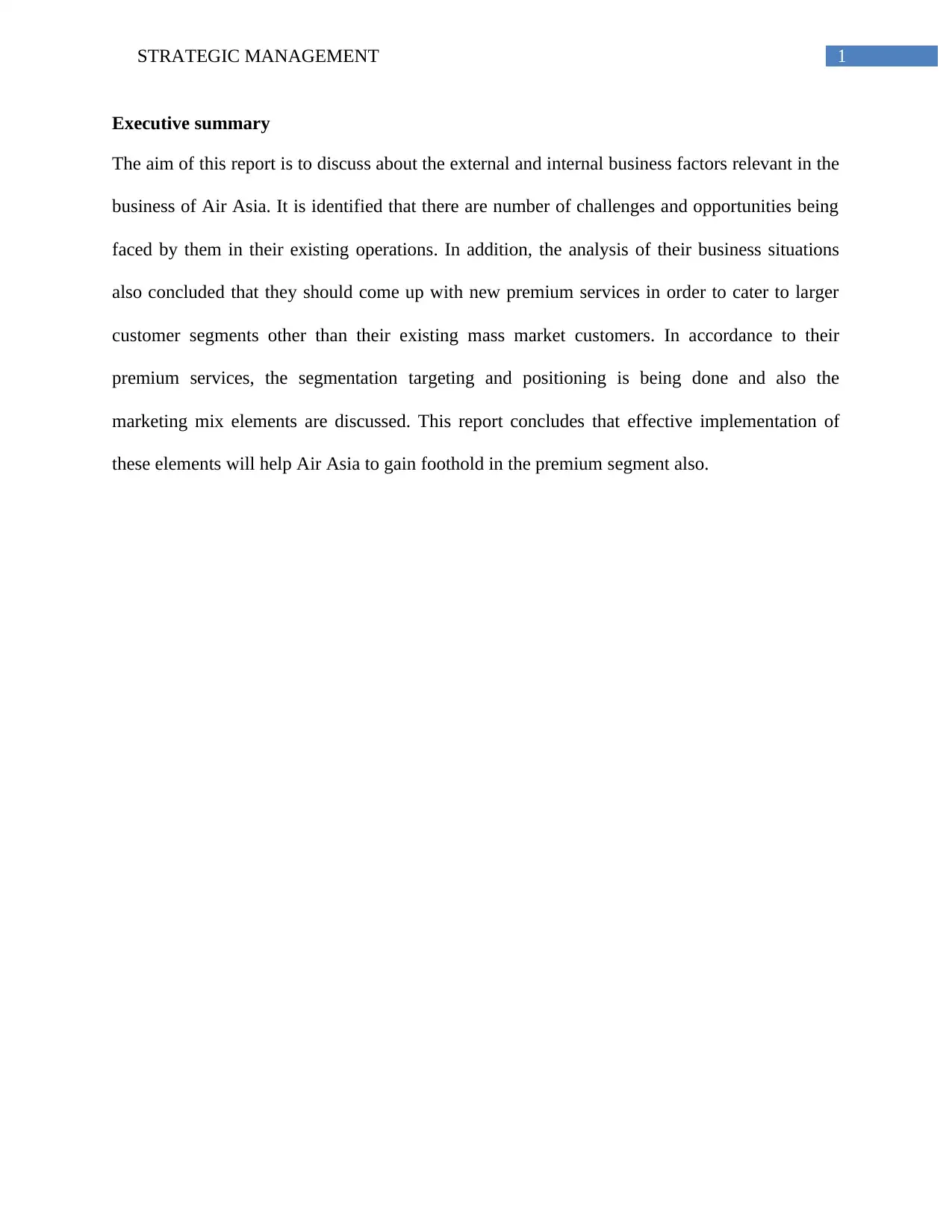
1STRATEGIC MANAGEMENT
Executive summary
The aim of this report is to discuss about the external and internal business factors relevant in the
business of Air Asia. It is identified that there are number of challenges and opportunities being
faced by them in their existing operations. In addition, the analysis of their business situations
also concluded that they should come up with new premium services in order to cater to larger
customer segments other than their existing mass market customers. In accordance to their
premium services, the segmentation targeting and positioning is being done and also the
marketing mix elements are discussed. This report concludes that effective implementation of
these elements will help Air Asia to gain foothold in the premium segment also.
Executive summary
The aim of this report is to discuss about the external and internal business factors relevant in the
business of Air Asia. It is identified that there are number of challenges and opportunities being
faced by them in their existing operations. In addition, the analysis of their business situations
also concluded that they should come up with new premium services in order to cater to larger
customer segments other than their existing mass market customers. In accordance to their
premium services, the segmentation targeting and positioning is being done and also the
marketing mix elements are discussed. This report concludes that effective implementation of
these elements will help Air Asia to gain foothold in the premium segment also.
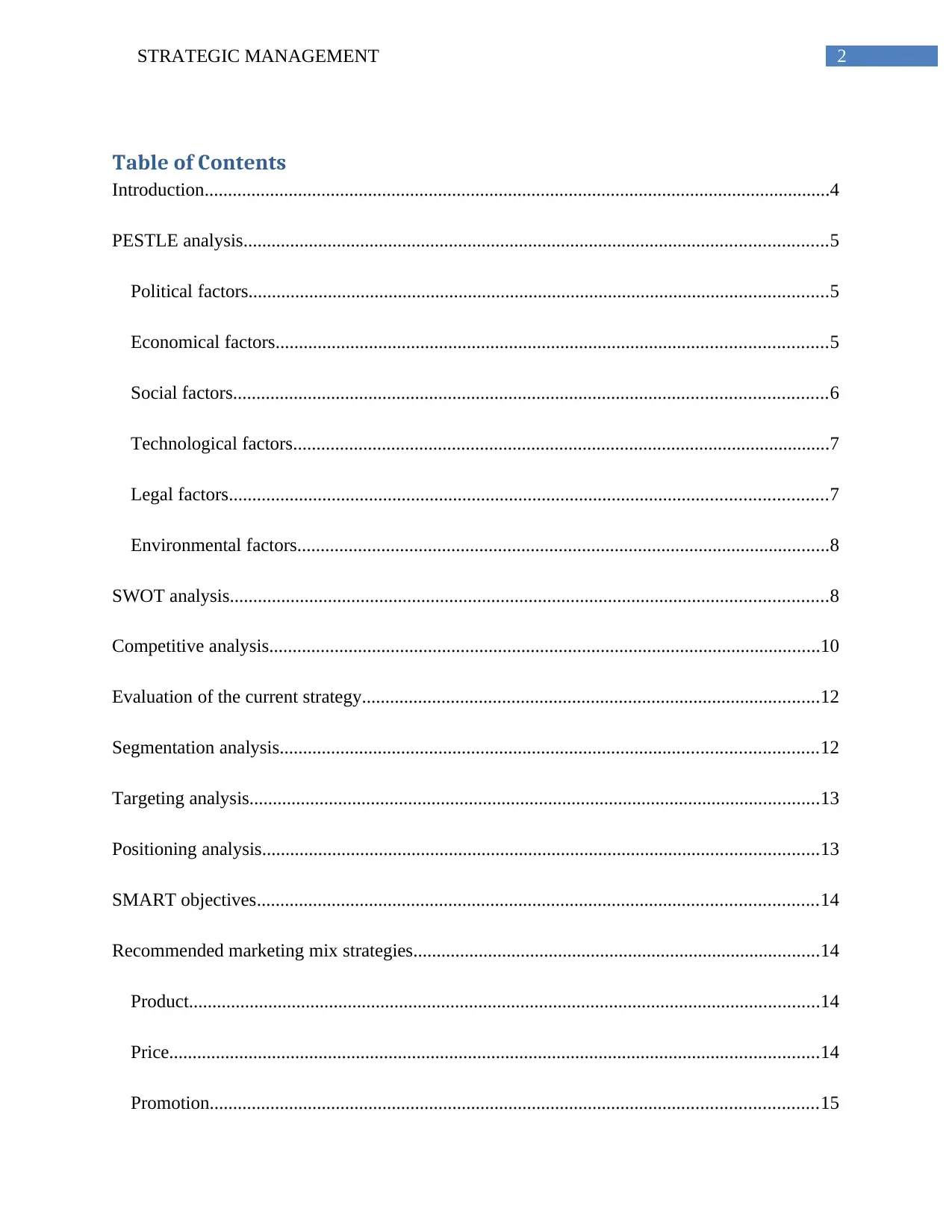
2STRATEGIC MANAGEMENT
Table of Contents
Introduction......................................................................................................................................4
PESTLE analysis.............................................................................................................................5
Political factors............................................................................................................................5
Economical factors......................................................................................................................5
Social factors...............................................................................................................................6
Technological factors...................................................................................................................7
Legal factors................................................................................................................................7
Environmental factors..................................................................................................................8
SWOT analysis................................................................................................................................8
Competitive analysis......................................................................................................................10
Evaluation of the current strategy..................................................................................................12
Segmentation analysis...................................................................................................................12
Targeting analysis..........................................................................................................................13
Positioning analysis.......................................................................................................................13
SMART objectives........................................................................................................................14
Recommended marketing mix strategies.......................................................................................14
Product.......................................................................................................................................14
Price...........................................................................................................................................14
Promotion..................................................................................................................................15
Table of Contents
Introduction......................................................................................................................................4
PESTLE analysis.............................................................................................................................5
Political factors............................................................................................................................5
Economical factors......................................................................................................................5
Social factors...............................................................................................................................6
Technological factors...................................................................................................................7
Legal factors................................................................................................................................7
Environmental factors..................................................................................................................8
SWOT analysis................................................................................................................................8
Competitive analysis......................................................................................................................10
Evaluation of the current strategy..................................................................................................12
Segmentation analysis...................................................................................................................12
Targeting analysis..........................................................................................................................13
Positioning analysis.......................................................................................................................13
SMART objectives........................................................................................................................14
Recommended marketing mix strategies.......................................................................................14
Product.......................................................................................................................................14
Price...........................................................................................................................................14
Promotion..................................................................................................................................15
⊘ This is a preview!⊘
Do you want full access?
Subscribe today to unlock all pages.

Trusted by 1+ million students worldwide
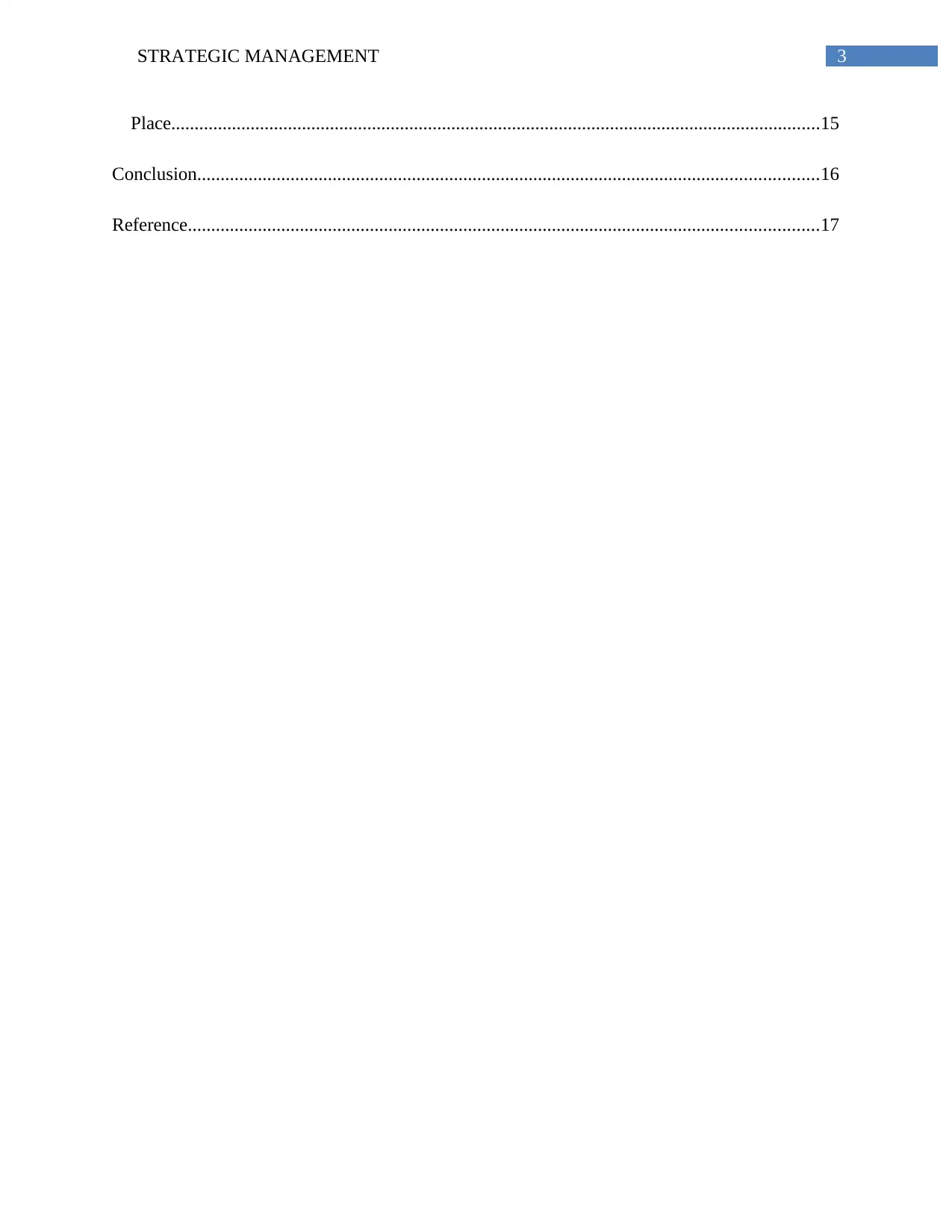
3STRATEGIC MANAGEMENT
Place...........................................................................................................................................15
Conclusion.....................................................................................................................................16
Reference.......................................................................................................................................17
Place...........................................................................................................................................15
Conclusion.....................................................................................................................................16
Reference.......................................................................................................................................17
Paraphrase This Document
Need a fresh take? Get an instant paraphrase of this document with our AI Paraphraser
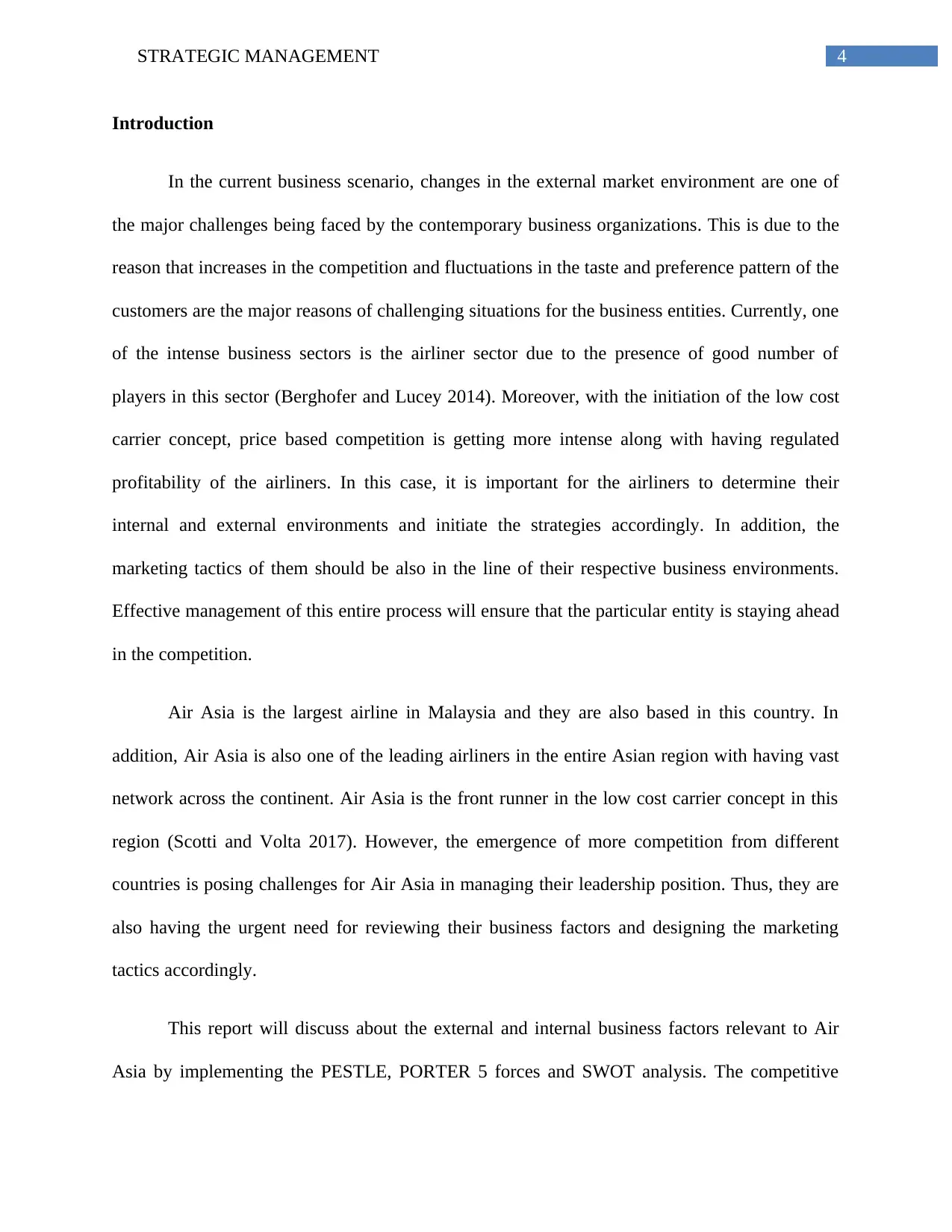
4STRATEGIC MANAGEMENT
Introduction
In the current business scenario, changes in the external market environment are one of
the major challenges being faced by the contemporary business organizations. This is due to the
reason that increases in the competition and fluctuations in the taste and preference pattern of the
customers are the major reasons of challenging situations for the business entities. Currently, one
of the intense business sectors is the airliner sector due to the presence of good number of
players in this sector (Berghofer and Lucey 2014). Moreover, with the initiation of the low cost
carrier concept, price based competition is getting more intense along with having regulated
profitability of the airliners. In this case, it is important for the airliners to determine their
internal and external environments and initiate the strategies accordingly. In addition, the
marketing tactics of them should be also in the line of their respective business environments.
Effective management of this entire process will ensure that the particular entity is staying ahead
in the competition.
Air Asia is the largest airline in Malaysia and they are also based in this country. In
addition, Air Asia is also one of the leading airliners in the entire Asian region with having vast
network across the continent. Air Asia is the front runner in the low cost carrier concept in this
region (Scotti and Volta 2017). However, the emergence of more competition from different
countries is posing challenges for Air Asia in managing their leadership position. Thus, they are
also having the urgent need for reviewing their business factors and designing the marketing
tactics accordingly.
This report will discuss about the external and internal business factors relevant to Air
Asia by implementing the PESTLE, PORTER 5 forces and SWOT analysis. The competitive
Introduction
In the current business scenario, changes in the external market environment are one of
the major challenges being faced by the contemporary business organizations. This is due to the
reason that increases in the competition and fluctuations in the taste and preference pattern of the
customers are the major reasons of challenging situations for the business entities. Currently, one
of the intense business sectors is the airliner sector due to the presence of good number of
players in this sector (Berghofer and Lucey 2014). Moreover, with the initiation of the low cost
carrier concept, price based competition is getting more intense along with having regulated
profitability of the airliners. In this case, it is important for the airliners to determine their
internal and external environments and initiate the strategies accordingly. In addition, the
marketing tactics of them should be also in the line of their respective business environments.
Effective management of this entire process will ensure that the particular entity is staying ahead
in the competition.
Air Asia is the largest airline in Malaysia and they are also based in this country. In
addition, Air Asia is also one of the leading airliners in the entire Asian region with having vast
network across the continent. Air Asia is the front runner in the low cost carrier concept in this
region (Scotti and Volta 2017). However, the emergence of more competition from different
countries is posing challenges for Air Asia in managing their leadership position. Thus, they are
also having the urgent need for reviewing their business factors and designing the marketing
tactics accordingly.
This report will discuss about the external and internal business factors relevant to Air
Asia by implementing the PESTLE, PORTER 5 forces and SWOT analysis. The competitive
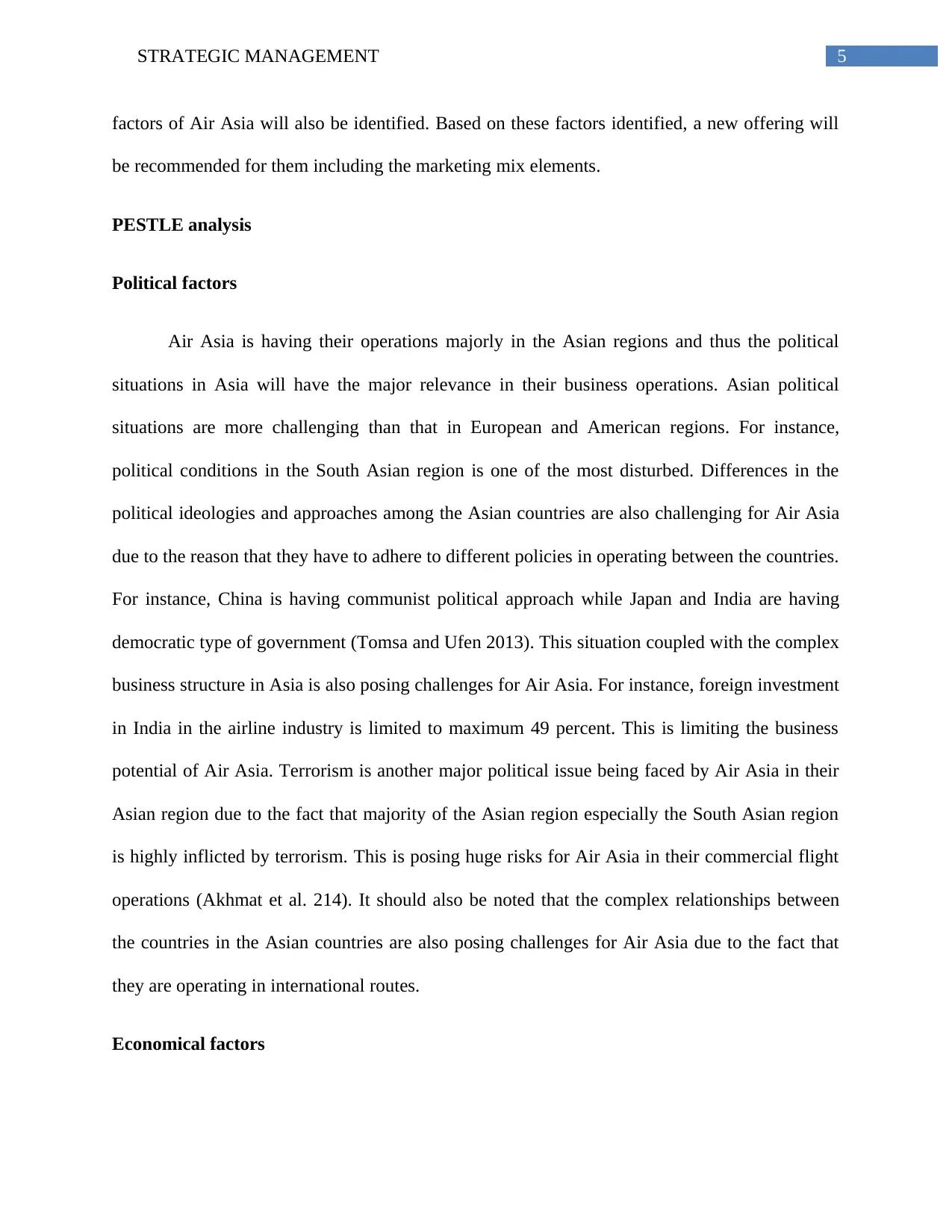
5STRATEGIC MANAGEMENT
factors of Air Asia will also be identified. Based on these factors identified, a new offering will
be recommended for them including the marketing mix elements.
PESTLE analysis
Political factors
Air Asia is having their operations majorly in the Asian regions and thus the political
situations in Asia will have the major relevance in their business operations. Asian political
situations are more challenging than that in European and American regions. For instance,
political conditions in the South Asian region is one of the most disturbed. Differences in the
political ideologies and approaches among the Asian countries are also challenging for Air Asia
due to the reason that they have to adhere to different policies in operating between the countries.
For instance, China is having communist political approach while Japan and India are having
democratic type of government (Tomsa and Ufen 2013). This situation coupled with the complex
business structure in Asia is also posing challenges for Air Asia. For instance, foreign investment
in India in the airline industry is limited to maximum 49 percent. This is limiting the business
potential of Air Asia. Terrorism is another major political issue being faced by Air Asia in their
Asian region due to the fact that majority of the Asian region especially the South Asian region
is highly inflicted by terrorism. This is posing huge risks for Air Asia in their commercial flight
operations (Akhmat et al. 214). It should also be noted that the complex relationships between
the countries in the Asian countries are also posing challenges for Air Asia due to the fact that
they are operating in international routes.
Economical factors
factors of Air Asia will also be identified. Based on these factors identified, a new offering will
be recommended for them including the marketing mix elements.
PESTLE analysis
Political factors
Air Asia is having their operations majorly in the Asian regions and thus the political
situations in Asia will have the major relevance in their business operations. Asian political
situations are more challenging than that in European and American regions. For instance,
political conditions in the South Asian region is one of the most disturbed. Differences in the
political ideologies and approaches among the Asian countries are also challenging for Air Asia
due to the reason that they have to adhere to different policies in operating between the countries.
For instance, China is having communist political approach while Japan and India are having
democratic type of government (Tomsa and Ufen 2013). This situation coupled with the complex
business structure in Asia is also posing challenges for Air Asia. For instance, foreign investment
in India in the airline industry is limited to maximum 49 percent. This is limiting the business
potential of Air Asia. Terrorism is another major political issue being faced by Air Asia in their
Asian region due to the fact that majority of the Asian region especially the South Asian region
is highly inflicted by terrorism. This is posing huge risks for Air Asia in their commercial flight
operations (Akhmat et al. 214). It should also be noted that the complex relationships between
the countries in the Asian countries are also posing challenges for Air Asia due to the fact that
they are operating in international routes.
Economical factors
⊘ This is a preview!⊘
Do you want full access?
Subscribe today to unlock all pages.

Trusted by 1+ million students worldwide
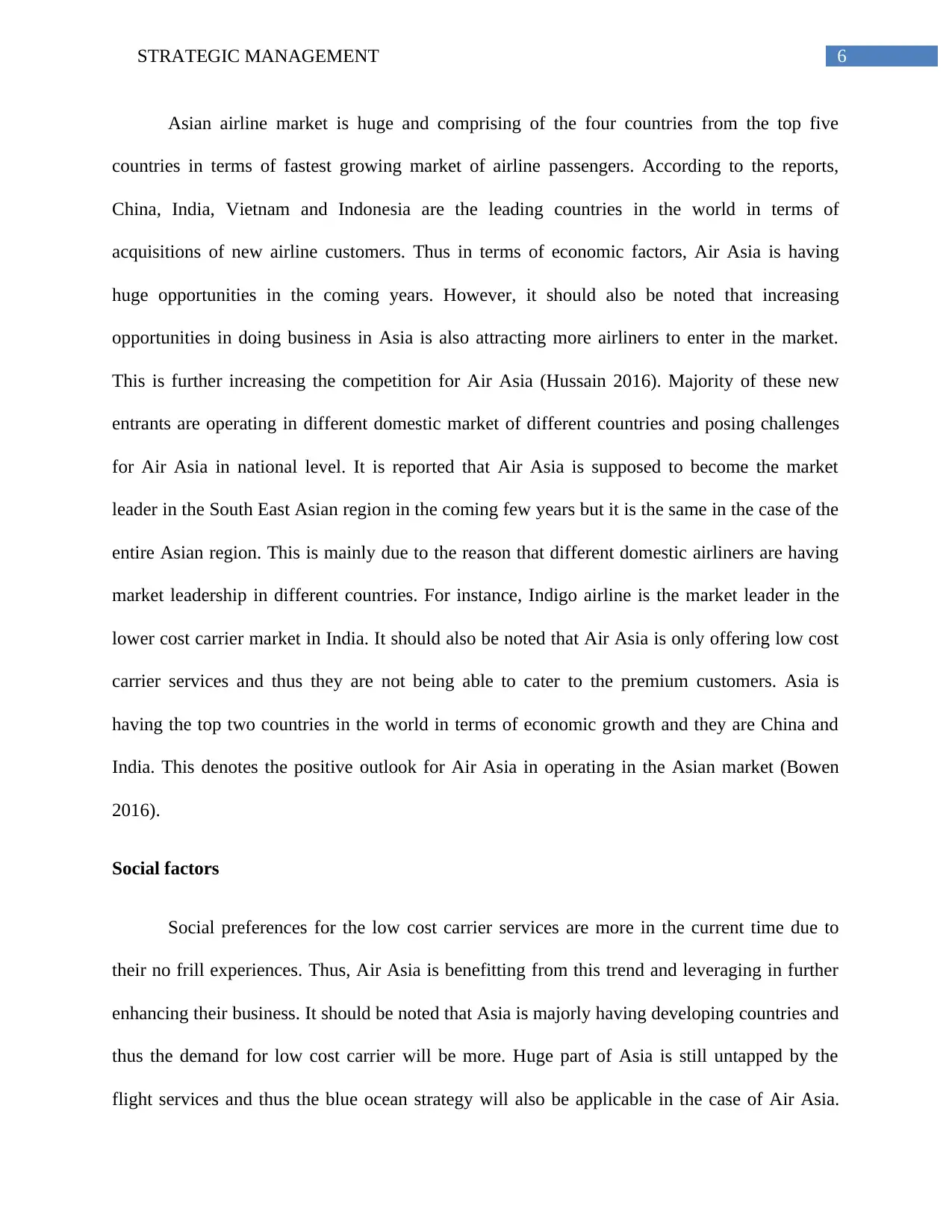
6STRATEGIC MANAGEMENT
Asian airline market is huge and comprising of the four countries from the top five
countries in terms of fastest growing market of airline passengers. According to the reports,
China, India, Vietnam and Indonesia are the leading countries in the world in terms of
acquisitions of new airline customers. Thus in terms of economic factors, Air Asia is having
huge opportunities in the coming years. However, it should also be noted that increasing
opportunities in doing business in Asia is also attracting more airliners to enter in the market.
This is further increasing the competition for Air Asia (Hussain 2016). Majority of these new
entrants are operating in different domestic market of different countries and posing challenges
for Air Asia in national level. It is reported that Air Asia is supposed to become the market
leader in the South East Asian region in the coming few years but it is the same in the case of the
entire Asian region. This is mainly due to the reason that different domestic airliners are having
market leadership in different countries. For instance, Indigo airline is the market leader in the
lower cost carrier market in India. It should also be noted that Air Asia is only offering low cost
carrier services and thus they are not being able to cater to the premium customers. Asia is
having the top two countries in the world in terms of economic growth and they are China and
India. This denotes the positive outlook for Air Asia in operating in the Asian market (Bowen
2016).
Social factors
Social preferences for the low cost carrier services are more in the current time due to
their no frill experiences. Thus, Air Asia is benefitting from this trend and leveraging in further
enhancing their business. It should be noted that Asia is majorly having developing countries and
thus the demand for low cost carrier will be more. Huge part of Asia is still untapped by the
flight services and thus the blue ocean strategy will also be applicable in the case of Air Asia.
Asian airline market is huge and comprising of the four countries from the top five
countries in terms of fastest growing market of airline passengers. According to the reports,
China, India, Vietnam and Indonesia are the leading countries in the world in terms of
acquisitions of new airline customers. Thus in terms of economic factors, Air Asia is having
huge opportunities in the coming years. However, it should also be noted that increasing
opportunities in doing business in Asia is also attracting more airliners to enter in the market.
This is further increasing the competition for Air Asia (Hussain 2016). Majority of these new
entrants are operating in different domestic market of different countries and posing challenges
for Air Asia in national level. It is reported that Air Asia is supposed to become the market
leader in the South East Asian region in the coming few years but it is the same in the case of the
entire Asian region. This is mainly due to the reason that different domestic airliners are having
market leadership in different countries. For instance, Indigo airline is the market leader in the
lower cost carrier market in India. It should also be noted that Air Asia is only offering low cost
carrier services and thus they are not being able to cater to the premium customers. Asia is
having the top two countries in the world in terms of economic growth and they are China and
India. This denotes the positive outlook for Air Asia in operating in the Asian market (Bowen
2016).
Social factors
Social preferences for the low cost carrier services are more in the current time due to
their no frill experiences. Thus, Air Asia is benefitting from this trend and leveraging in further
enhancing their business. It should be noted that Asia is majorly having developing countries and
thus the demand for low cost carrier will be more. Huge part of Asia is still untapped by the
flight services and thus the blue ocean strategy will also be applicable in the case of Air Asia.
Paraphrase This Document
Need a fresh take? Get an instant paraphrase of this document with our AI Paraphraser
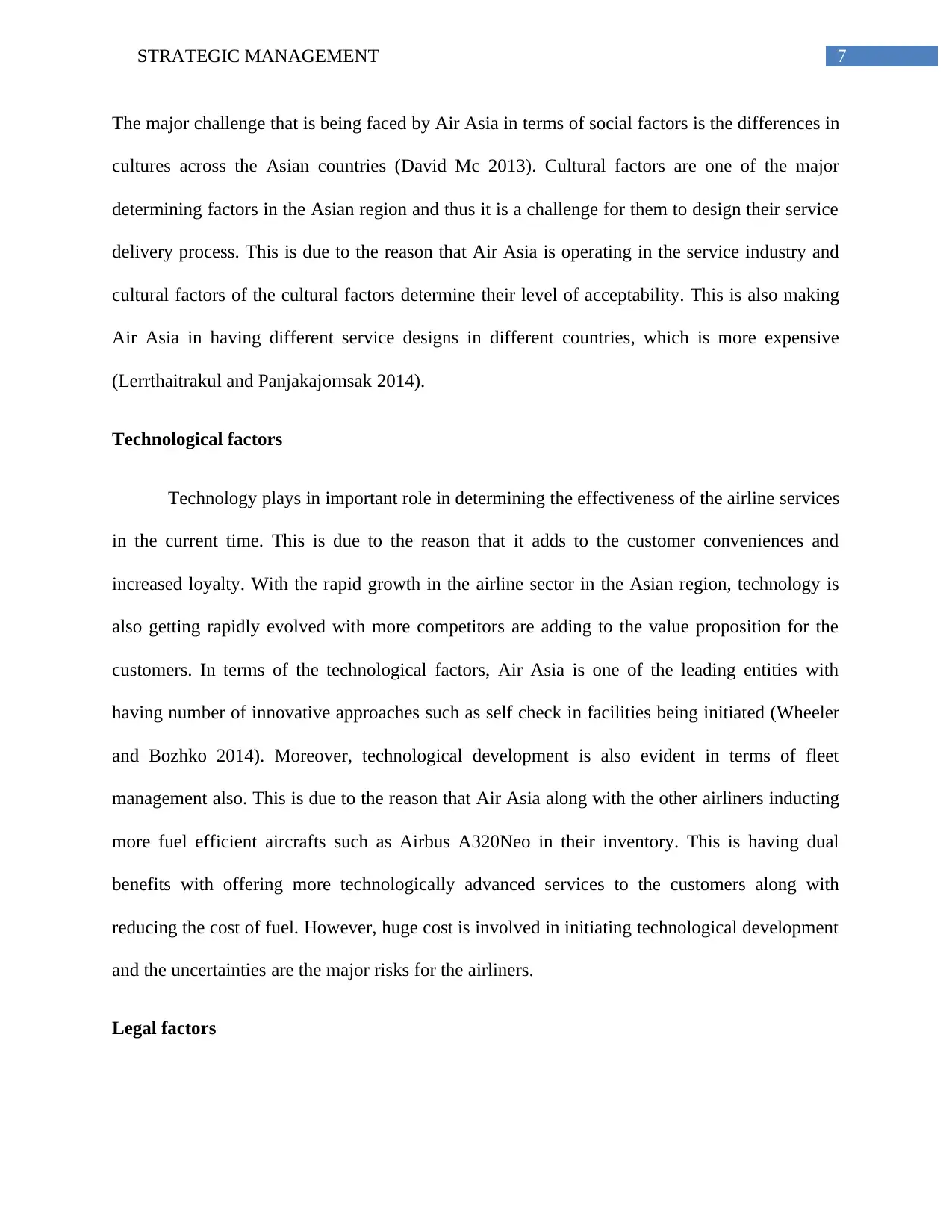
7STRATEGIC MANAGEMENT
The major challenge that is being faced by Air Asia in terms of social factors is the differences in
cultures across the Asian countries (David Mc 2013). Cultural factors are one of the major
determining factors in the Asian region and thus it is a challenge for them to design their service
delivery process. This is due to the reason that Air Asia is operating in the service industry and
cultural factors of the cultural factors determine their level of acceptability. This is also making
Air Asia in having different service designs in different countries, which is more expensive
(Lerrthaitrakul and Panjakajornsak 2014).
Technological factors
Technology plays in important role in determining the effectiveness of the airline services
in the current time. This is due to the reason that it adds to the customer conveniences and
increased loyalty. With the rapid growth in the airline sector in the Asian region, technology is
also getting rapidly evolved with more competitors are adding to the value proposition for the
customers. In terms of the technological factors, Air Asia is one of the leading entities with
having number of innovative approaches such as self check in facilities being initiated (Wheeler
and Bozhko 2014). Moreover, technological development is also evident in terms of fleet
management also. This is due to the reason that Air Asia along with the other airliners inducting
more fuel efficient aircrafts such as Airbus A320Neo in their inventory. This is having dual
benefits with offering more technologically advanced services to the customers along with
reducing the cost of fuel. However, huge cost is involved in initiating technological development
and the uncertainties are the major risks for the airliners.
Legal factors
The major challenge that is being faced by Air Asia in terms of social factors is the differences in
cultures across the Asian countries (David Mc 2013). Cultural factors are one of the major
determining factors in the Asian region and thus it is a challenge for them to design their service
delivery process. This is due to the reason that Air Asia is operating in the service industry and
cultural factors of the cultural factors determine their level of acceptability. This is also making
Air Asia in having different service designs in different countries, which is more expensive
(Lerrthaitrakul and Panjakajornsak 2014).
Technological factors
Technology plays in important role in determining the effectiveness of the airline services
in the current time. This is due to the reason that it adds to the customer conveniences and
increased loyalty. With the rapid growth in the airline sector in the Asian region, technology is
also getting rapidly evolved with more competitors are adding to the value proposition for the
customers. In terms of the technological factors, Air Asia is one of the leading entities with
having number of innovative approaches such as self check in facilities being initiated (Wheeler
and Bozhko 2014). Moreover, technological development is also evident in terms of fleet
management also. This is due to the reason that Air Asia along with the other airliners inducting
more fuel efficient aircrafts such as Airbus A320Neo in their inventory. This is having dual
benefits with offering more technologically advanced services to the customers along with
reducing the cost of fuel. However, huge cost is involved in initiating technological development
and the uncertainties are the major risks for the airliners.
Legal factors
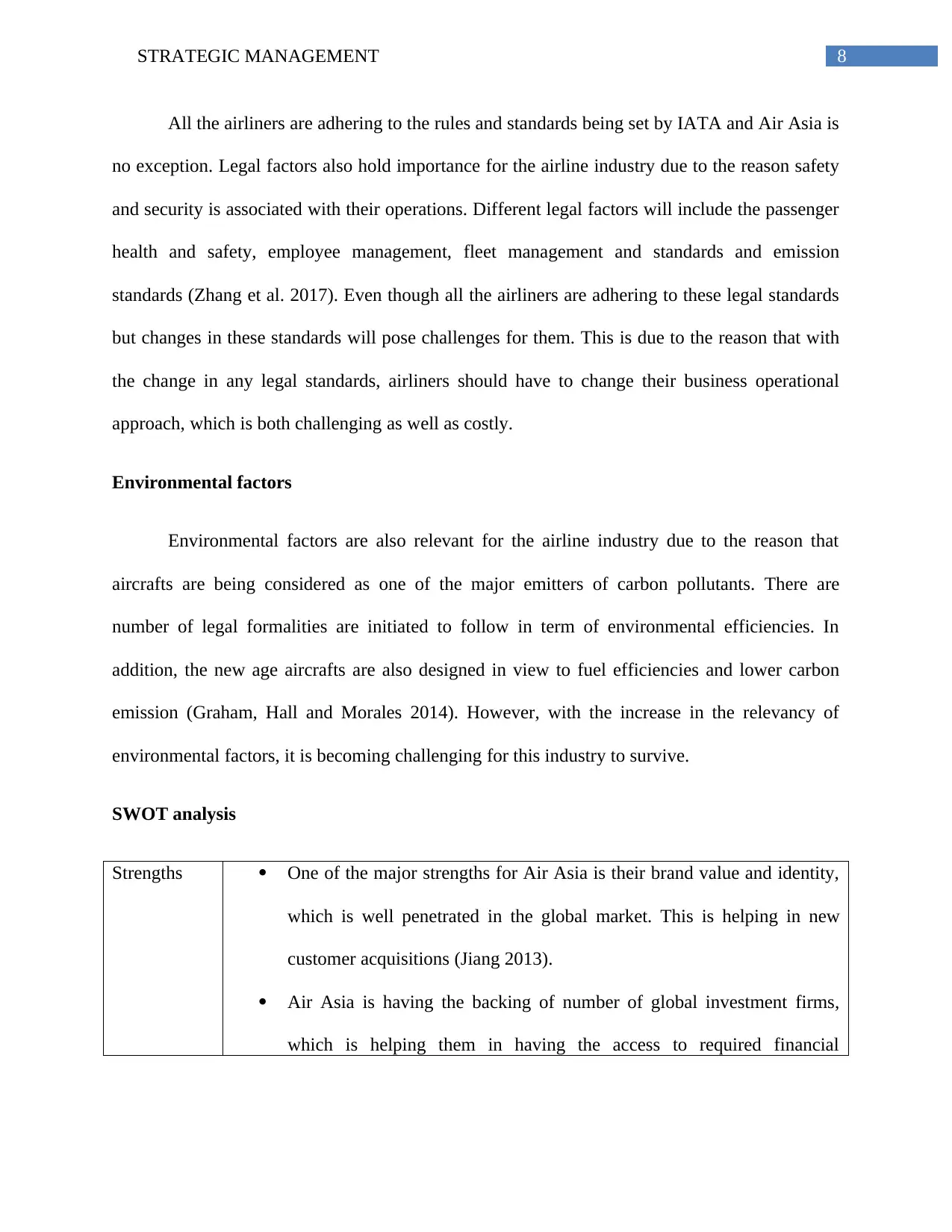
8STRATEGIC MANAGEMENT
All the airliners are adhering to the rules and standards being set by IATA and Air Asia is
no exception. Legal factors also hold importance for the airline industry due to the reason safety
and security is associated with their operations. Different legal factors will include the passenger
health and safety, employee management, fleet management and standards and emission
standards (Zhang et al. 2017). Even though all the airliners are adhering to these legal standards
but changes in these standards will pose challenges for them. This is due to the reason that with
the change in any legal standards, airliners should have to change their business operational
approach, which is both challenging as well as costly.
Environmental factors
Environmental factors are also relevant for the airline industry due to the reason that
aircrafts are being considered as one of the major emitters of carbon pollutants. There are
number of legal formalities are initiated to follow in term of environmental efficiencies. In
addition, the new age aircrafts are also designed in view to fuel efficiencies and lower carbon
emission (Graham, Hall and Morales 2014). However, with the increase in the relevancy of
environmental factors, it is becoming challenging for this industry to survive.
SWOT analysis
Strengths One of the major strengths for Air Asia is their brand value and identity,
which is well penetrated in the global market. This is helping in new
customer acquisitions (Jiang 2013).
Air Asia is having the backing of number of global investment firms,
which is helping them in having the access to required financial
All the airliners are adhering to the rules and standards being set by IATA and Air Asia is
no exception. Legal factors also hold importance for the airline industry due to the reason safety
and security is associated with their operations. Different legal factors will include the passenger
health and safety, employee management, fleet management and standards and emission
standards (Zhang et al. 2017). Even though all the airliners are adhering to these legal standards
but changes in these standards will pose challenges for them. This is due to the reason that with
the change in any legal standards, airliners should have to change their business operational
approach, which is both challenging as well as costly.
Environmental factors
Environmental factors are also relevant for the airline industry due to the reason that
aircrafts are being considered as one of the major emitters of carbon pollutants. There are
number of legal formalities are initiated to follow in term of environmental efficiencies. In
addition, the new age aircrafts are also designed in view to fuel efficiencies and lower carbon
emission (Graham, Hall and Morales 2014). However, with the increase in the relevancy of
environmental factors, it is becoming challenging for this industry to survive.
SWOT analysis
Strengths One of the major strengths for Air Asia is their brand value and identity,
which is well penetrated in the global market. This is helping in new
customer acquisitions (Jiang 2013).
Air Asia is having the backing of number of global investment firms,
which is helping them in having the access to required financial
⊘ This is a preview!⊘
Do you want full access?
Subscribe today to unlock all pages.

Trusted by 1+ million students worldwide
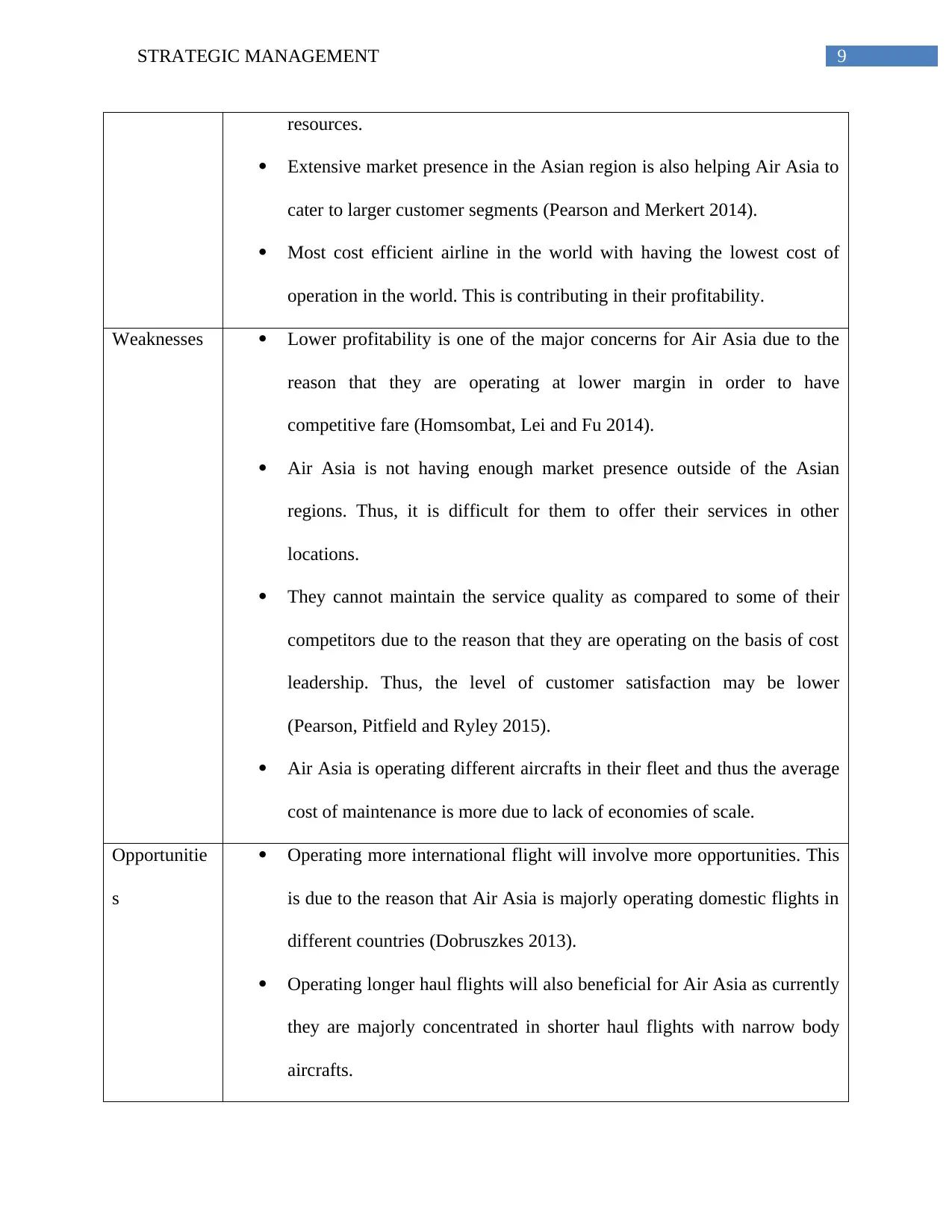
9STRATEGIC MANAGEMENT
resources.
Extensive market presence in the Asian region is also helping Air Asia to
cater to larger customer segments (Pearson and Merkert 2014).
Most cost efficient airline in the world with having the lowest cost of
operation in the world. This is contributing in their profitability.
Weaknesses Lower profitability is one of the major concerns for Air Asia due to the
reason that they are operating at lower margin in order to have
competitive fare (Homsombat, Lei and Fu 2014).
Air Asia is not having enough market presence outside of the Asian
regions. Thus, it is difficult for them to offer their services in other
locations.
They cannot maintain the service quality as compared to some of their
competitors due to the reason that they are operating on the basis of cost
leadership. Thus, the level of customer satisfaction may be lower
(Pearson, Pitfield and Ryley 2015).
Air Asia is operating different aircrafts in their fleet and thus the average
cost of maintenance is more due to lack of economies of scale.
Opportunitie
s
Operating more international flight will involve more opportunities. This
is due to the reason that Air Asia is majorly operating domestic flights in
different countries (Dobruszkes 2013).
Operating longer haul flights will also beneficial for Air Asia as currently
they are majorly concentrated in shorter haul flights with narrow body
aircrafts.
resources.
Extensive market presence in the Asian region is also helping Air Asia to
cater to larger customer segments (Pearson and Merkert 2014).
Most cost efficient airline in the world with having the lowest cost of
operation in the world. This is contributing in their profitability.
Weaknesses Lower profitability is one of the major concerns for Air Asia due to the
reason that they are operating at lower margin in order to have
competitive fare (Homsombat, Lei and Fu 2014).
Air Asia is not having enough market presence outside of the Asian
regions. Thus, it is difficult for them to offer their services in other
locations.
They cannot maintain the service quality as compared to some of their
competitors due to the reason that they are operating on the basis of cost
leadership. Thus, the level of customer satisfaction may be lower
(Pearson, Pitfield and Ryley 2015).
Air Asia is operating different aircrafts in their fleet and thus the average
cost of maintenance is more due to lack of economies of scale.
Opportunitie
s
Operating more international flight will involve more opportunities. This
is due to the reason that Air Asia is majorly operating domestic flights in
different countries (Dobruszkes 2013).
Operating longer haul flights will also beneficial for Air Asia as currently
they are majorly concentrated in shorter haul flights with narrow body
aircrafts.
Paraphrase This Document
Need a fresh take? Get an instant paraphrase of this document with our AI Paraphraser
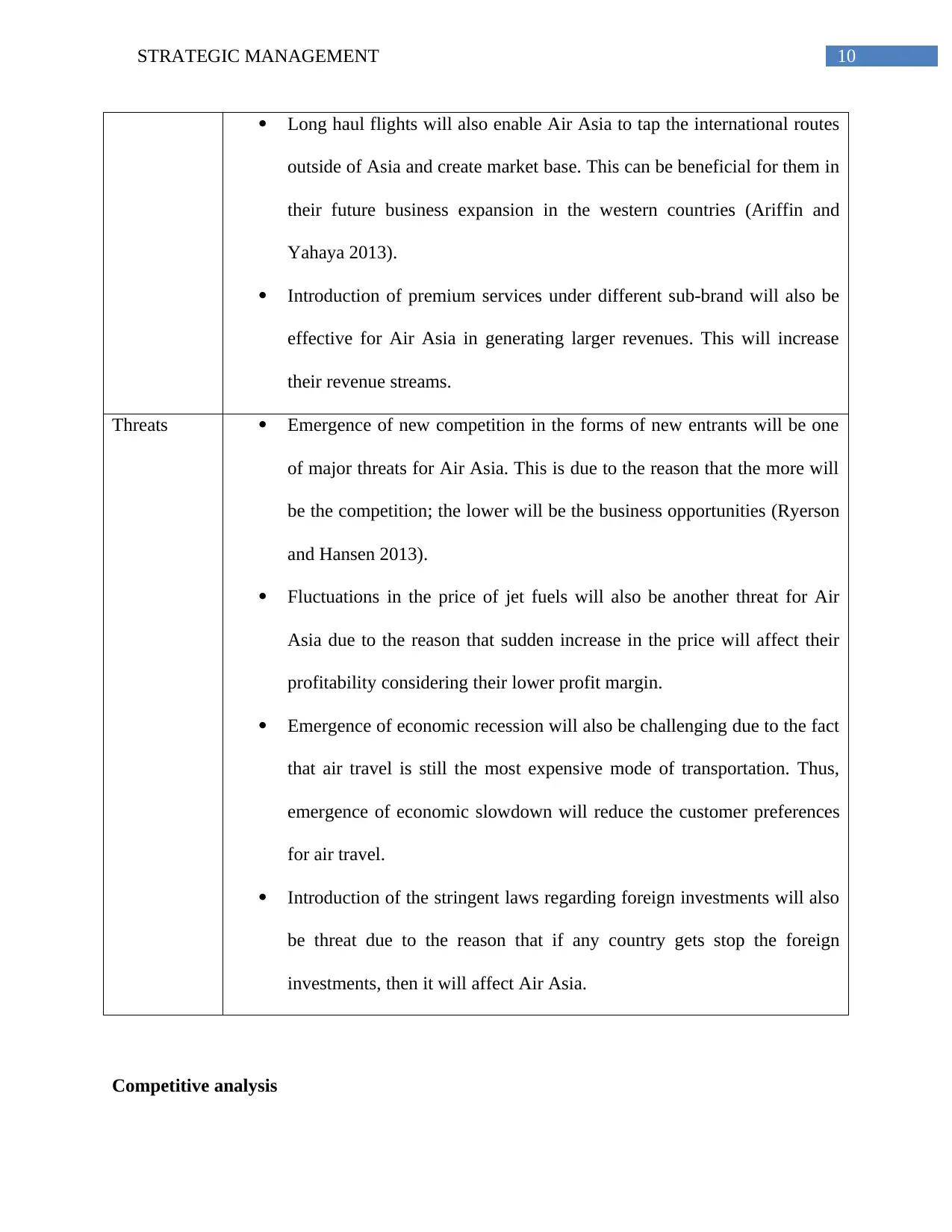
10STRATEGIC MANAGEMENT
Long haul flights will also enable Air Asia to tap the international routes
outside of Asia and create market base. This can be beneficial for them in
their future business expansion in the western countries (Ariffin and
Yahaya 2013).
Introduction of premium services under different sub-brand will also be
effective for Air Asia in generating larger revenues. This will increase
their revenue streams.
Threats Emergence of new competition in the forms of new entrants will be one
of major threats for Air Asia. This is due to the reason that the more will
be the competition; the lower will be the business opportunities (Ryerson
and Hansen 2013).
Fluctuations in the price of jet fuels will also be another threat for Air
Asia due to the reason that sudden increase in the price will affect their
profitability considering their lower profit margin.
Emergence of economic recession will also be challenging due to the fact
that air travel is still the most expensive mode of transportation. Thus,
emergence of economic slowdown will reduce the customer preferences
for air travel.
Introduction of the stringent laws regarding foreign investments will also
be threat due to the reason that if any country gets stop the foreign
investments, then it will affect Air Asia.
Competitive analysis
Long haul flights will also enable Air Asia to tap the international routes
outside of Asia and create market base. This can be beneficial for them in
their future business expansion in the western countries (Ariffin and
Yahaya 2013).
Introduction of premium services under different sub-brand will also be
effective for Air Asia in generating larger revenues. This will increase
their revenue streams.
Threats Emergence of new competition in the forms of new entrants will be one
of major threats for Air Asia. This is due to the reason that the more will
be the competition; the lower will be the business opportunities (Ryerson
and Hansen 2013).
Fluctuations in the price of jet fuels will also be another threat for Air
Asia due to the reason that sudden increase in the price will affect their
profitability considering their lower profit margin.
Emergence of economic recession will also be challenging due to the fact
that air travel is still the most expensive mode of transportation. Thus,
emergence of economic slowdown will reduce the customer preferences
for air travel.
Introduction of the stringent laws regarding foreign investments will also
be threat due to the reason that if any country gets stop the foreign
investments, then it will affect Air Asia.
Competitive analysis
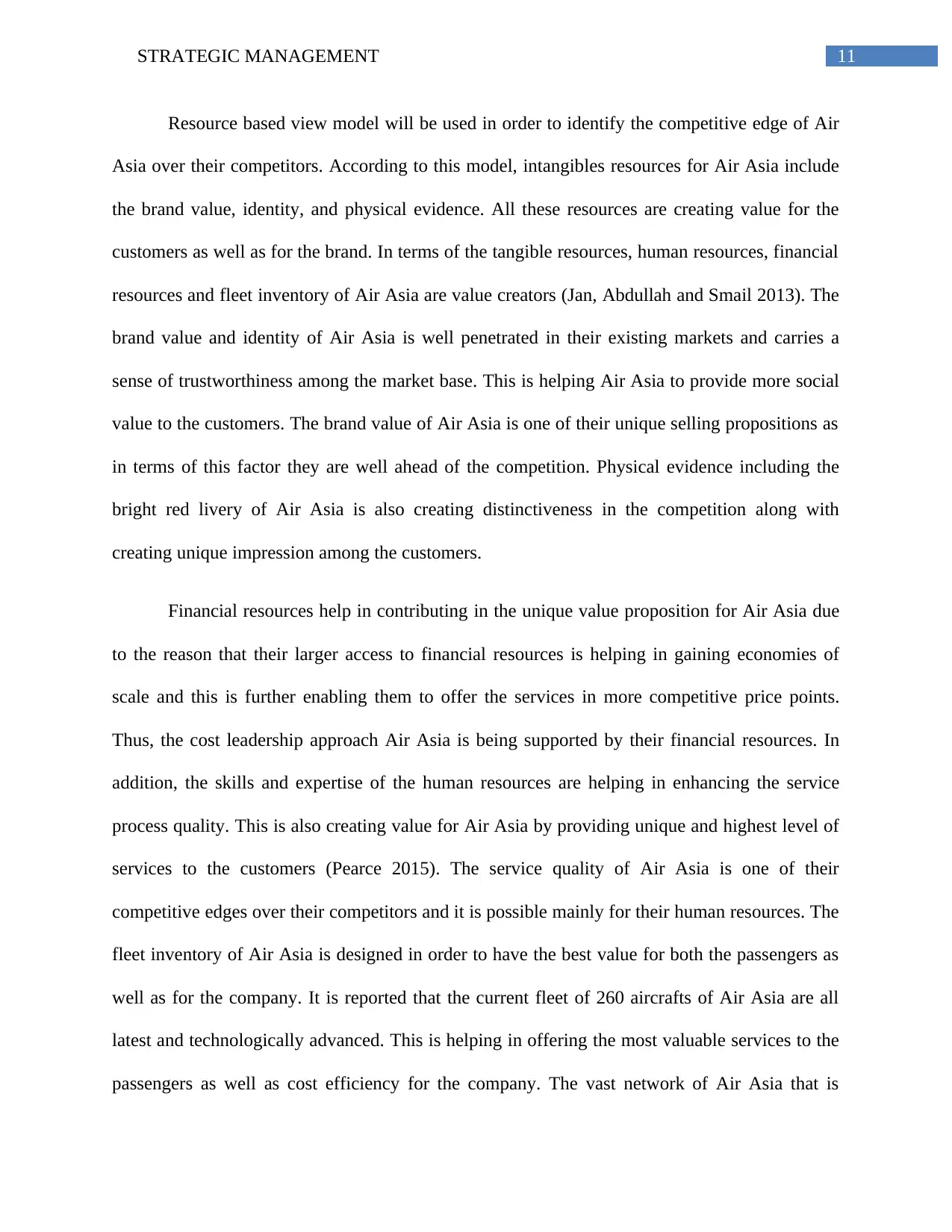
11STRATEGIC MANAGEMENT
Resource based view model will be used in order to identify the competitive edge of Air
Asia over their competitors. According to this model, intangibles resources for Air Asia include
the brand value, identity, and physical evidence. All these resources are creating value for the
customers as well as for the brand. In terms of the tangible resources, human resources, financial
resources and fleet inventory of Air Asia are value creators (Jan, Abdullah and Smail 2013). The
brand value and identity of Air Asia is well penetrated in their existing markets and carries a
sense of trustworthiness among the market base. This is helping Air Asia to provide more social
value to the customers. The brand value of Air Asia is one of their unique selling propositions as
in terms of this factor they are well ahead of the competition. Physical evidence including the
bright red livery of Air Asia is also creating distinctiveness in the competition along with
creating unique impression among the customers.
Financial resources help in contributing in the unique value proposition for Air Asia due
to the reason that their larger access to financial resources is helping in gaining economies of
scale and this is further enabling them to offer the services in more competitive price points.
Thus, the cost leadership approach Air Asia is being supported by their financial resources. In
addition, the skills and expertise of the human resources are helping in enhancing the service
process quality. This is also creating value for Air Asia by providing unique and highest level of
services to the customers (Pearce 2015). The service quality of Air Asia is one of their
competitive edges over their competitors and it is possible mainly for their human resources. The
fleet inventory of Air Asia is designed in order to have the best value for both the passengers as
well as for the company. It is reported that the current fleet of 260 aircrafts of Air Asia are all
latest and technologically advanced. This is helping in offering the most valuable services to the
passengers as well as cost efficiency for the company. The vast network of Air Asia that is
Resource based view model will be used in order to identify the competitive edge of Air
Asia over their competitors. According to this model, intangibles resources for Air Asia include
the brand value, identity, and physical evidence. All these resources are creating value for the
customers as well as for the brand. In terms of the tangible resources, human resources, financial
resources and fleet inventory of Air Asia are value creators (Jan, Abdullah and Smail 2013). The
brand value and identity of Air Asia is well penetrated in their existing markets and carries a
sense of trustworthiness among the market base. This is helping Air Asia to provide more social
value to the customers. The brand value of Air Asia is one of their unique selling propositions as
in terms of this factor they are well ahead of the competition. Physical evidence including the
bright red livery of Air Asia is also creating distinctiveness in the competition along with
creating unique impression among the customers.
Financial resources help in contributing in the unique value proposition for Air Asia due
to the reason that their larger access to financial resources is helping in gaining economies of
scale and this is further enabling them to offer the services in more competitive price points.
Thus, the cost leadership approach Air Asia is being supported by their financial resources. In
addition, the skills and expertise of the human resources are helping in enhancing the service
process quality. This is also creating value for Air Asia by providing unique and highest level of
services to the customers (Pearce 2015). The service quality of Air Asia is one of their
competitive edges over their competitors and it is possible mainly for their human resources. The
fleet inventory of Air Asia is designed in order to have the best value for both the passengers as
well as for the company. It is reported that the current fleet of 260 aircrafts of Air Asia are all
latest and technologically advanced. This is helping in offering the most valuable services to the
passengers as well as cost efficiency for the company. The vast network of Air Asia that is
⊘ This is a preview!⊘
Do you want full access?
Subscribe today to unlock all pages.

Trusted by 1+ million students worldwide
1 out of 20
Related Documents
Your All-in-One AI-Powered Toolkit for Academic Success.
+13062052269
info@desklib.com
Available 24*7 on WhatsApp / Email
![[object Object]](/_next/static/media/star-bottom.7253800d.svg)
Unlock your academic potential
Copyright © 2020–2025 A2Z Services. All Rights Reserved. Developed and managed by ZUCOL.





